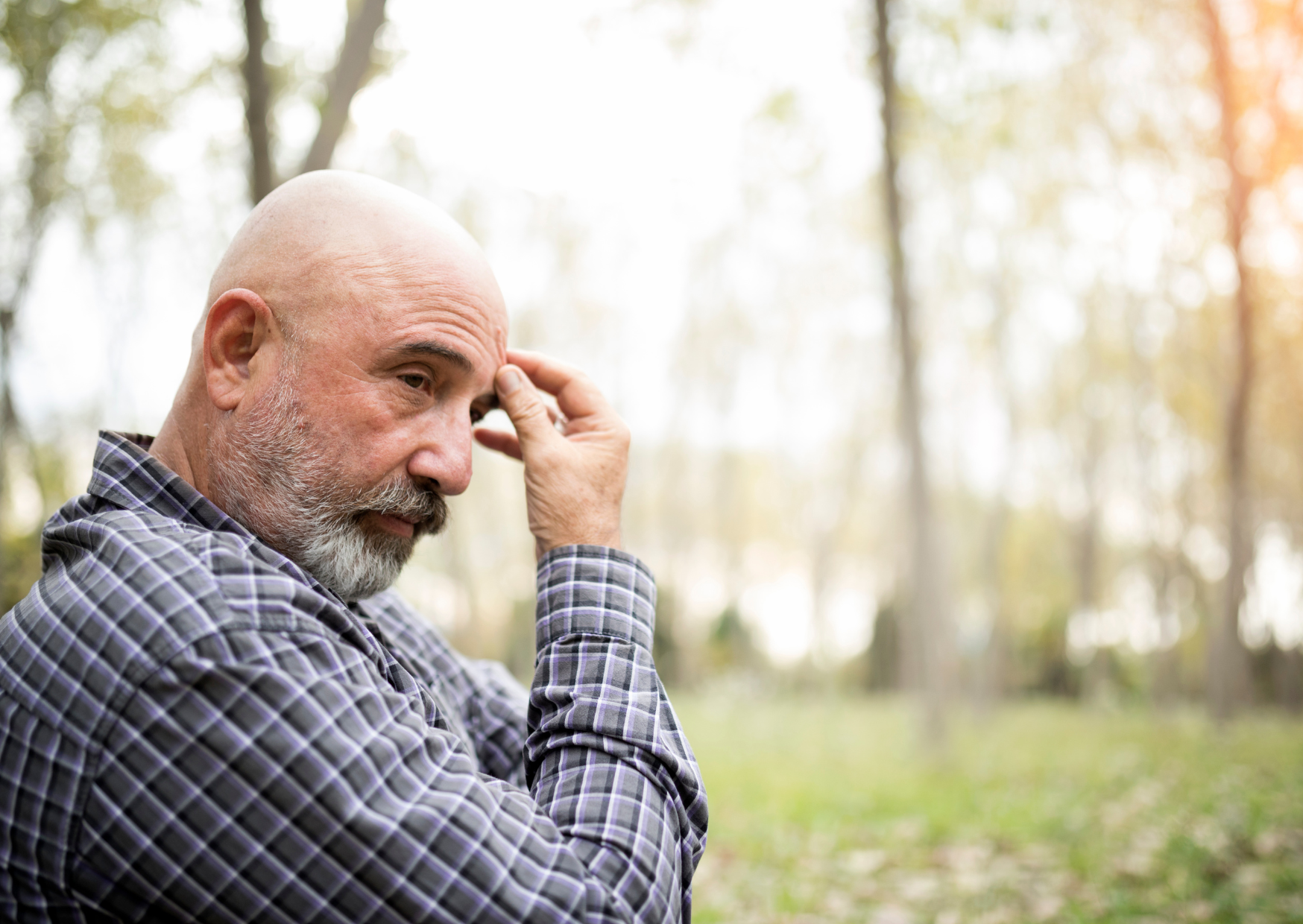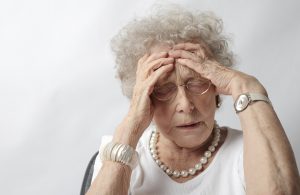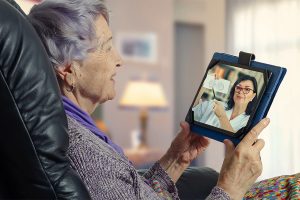A certain level of anxiety is a natural part of our daily lives. Things like bills, public speaking, and unfamiliar settings can all cause us to feel anxious or nervous. For some, these feelings can become overwhelming and severely impact their lives—these heightened fears are often signs of an anxiety disorder.
It can be difficult to tell if a loved one is struggling with anxiety. This is particularly true for elders, as many anxiety disorders manifest as physical issues in older patients. According to the Cable News Network (CNN), seniors are more likely to complain of somatic (physical) issues, rather than psychological symptoms. This tendency to focus on anxiety’s physical effects can cause caregivers and healthcare providers alike to initially dismiss any concerns that the problem is mental.
The common societal belief that older people are unable or unwilling to change their ways can exacerbate this. Because of these stereotypes, healthcare providers may be unconsciously biased to write older patients off as lost causes, believing that it is simply too late to administer psychiatric care.
Senior anxiety does not have to go unnoticed. By understanding how and why it manifests, you can better your chances of catching, and treating, anxiety disorders in your elderly loved ones.
What is an anxiety disorder?
The term “anxiety disorder” is used to describe the group of mental health conditions which cause a heightened sense of anxiety, fear, or dread. While anxiety, fear, and dread are all naturally occurring emotions, anxiety disorders are characterized by overwhelming, persistent, and continued anxiety. In seniors, these disorders are especially common—it is thought that 10% to 20% of older adults are currently living with an anxiety disorder.
Usual anxiety v.s. heightened anxiety
It is natural to feel anxious periodically. For example, you may be worried about a loved one who is out late and has not called, or a small child who is standing in a precarious spot. However, these fears typically resolve themselves when the person gets home safely. For someone with an anxiety disorder, fears often persist throughout the day—even if there is no clear reason to be worried. Should a loved one be experiencing sudden and inexplicable feelings of doom or fear, or long-lasting anxieties that prevent them from participating in usual activities, they may have an anxiety disorder.
Types of anxiety disorders
There are five main types of anxiety disorders, with the most common being Generalized Anxiety Disorder (GAD). According to the Anxiety and Depression Association of America, around 14% to 17% of seniors over 65 are diagnosed with GAD—and this is thought to be an undercount, as anxiety is often overlooked in older patients. This anxiety disorder also encompasses the largest range of common symptoms.
Also under the anxiety disorder umbrella are panic disorders, characterized by intensely distressing episodes known as panic attacks. These attacks can happen randomly and are not necessarily triggered by any situation or occurrence. However, in the case of another anxiety disorder, Post Traumatic Stress Disorder (PTSD), flashbacks—which can feel very similar to panic attacks—are triggered by things that remind the person of past trauma. Older adults who have suffered trauma through wars or experienced natural disasters have a heightened risk of developing PTSD.
The final two main types are phobias and Obsessive Compulsive Disorder (OCD). Phobias are intense fears of a specific thing or event and are often irrational. Common phobias for seniors include fears of falls, family tragedies, death, and dental procedures. Those with OCD may experience intrusive thoughts similar to phobias, but paired with compulsions to do certain set things over and over in order to stop those bad things from happening, or to feel a sense of control. These obsessive fears can include thoughts of possible harm coming to their loved ones.
What causes senior anxiety?
While there are many causes of anxiety disorders, the most common for older adults are:
Stressful events
If your seniors have experienced significant stress recently, they are more likely to develop an anxiety disorder. Examples of these situations include the death of a loved one, financial insecurity, or changes in their living arrangements.
Stressful events can also be those experienced during childhood and adolescence. Older adults may develop anxiety in response to a trigger, such as a new disability or health condition, which relates to past trauma. Feelings of helplessness, loneliness, and pain can all be triggers for forgotten or buried experiences.
Age-related challenges
As we age, our lives gradually change. While this is often exciting, aging can also lead to losses in mobility and independence, resulting in heightened anxiety. Examples of this include health conditions such as arthritis, diabetes, and insomnia. As mentioned above, feelings of helplessness or losing the ability to do things freely can result in the reemergence of past trauma, thus elevating the risks of developing an anxiety disorder.
Genetics
Anxiety can be passed down genetically through families. According to an article published on PubMed, Generalized Anxiety Disorder has a heritability of around 30%, and can also be influenced by a parent’s early life experiences through epigenetic factors. While epigenetics, or the study of the impacts of gene expression in organisms, is still an emerging field, it is currently understood that a parent’s childhood experiences (including traumas, mental health issues, and more) can have a direct effect on their child’s—purely through tiny changes to their gene expression.
This means that if your senior’s parents had GAD themselves, or had a mental health condition with epigenetic significance, your senior has a higher likelihood of developing an anxiety disorder themselves.
Substances
Finally, certain substances have been proven to elevate anxiety levels—even when taken correctly. Certain medications, for example, can cause heightened anxiety even at the correct dosage.
Other anxiety-inducing substances include nicotine and alcohol. While these substances can provide relief from stress, excessive use can actually cause stress and anxiety to worsen. With age, the body’s ability to process alcohol decreases, meaning that older adults may experience stronger effects with the same amount of alcohol consumption. Caffeine, another common stimulant, has been directly linked to heightened anxiety. According to a recent PubMed article, caffeine’s stimulation of the body’s nervous system causes the release of adrenaline, which can cause anxiety and nervousness.
Signs to look out for
But how do you know if an elderly loved one is struggling with anxiety? As mentioned earlier, anxiety often presents as a somatic (physical) issue in seniors, but mental symptoms can also appear. Listed below are some of the most common symptoms for each of the five types of anxiety disorders, as related to seniors.
Generalized Anxiety Disorder (GAD)
GAD is the most common of anxiety disorders, and many of its symptoms overlap with others. Seniors with GAD, and most other anxiety disorders, will often sweat, tremble, and experience nausea, stomach pains, and headaches. They may complain of muscle tension, a racing heart rate, and have a decreased appetite—this may also lead to sudden or excessive weight loss. Seniors may also describe feeling out of breath or experience hot flashes.
Mental symptoms can include a change in demeanor, restlessness, trouble focusing, racing thoughts, and feelings of hopelessness. In addition, they may have trouble sleeping, and begin to avoid and withdraw from their usual activities. These signs are often less noticeable, so extra care should be taken to catch these changes.
Panic disorders
The biggest indicator of a panic disorder is a panic attack. These attacks are sudden episodes of intense fear, characterized by a racing heart rate, chest pain, nausea, and feeling faint or disconnected from reality. They may also cause a choking feeling, or feeling unable to get a full breath of air. Panic attacks usually peak within 10 minutes, and may be initially mistaken for heart attacks or strokes.
Panic attacks are usually unexpected and do not have a clear cause or trigger. However, should someone experience multiple panic attacks in a certain situation—for example, while at a restaurant or on the bus—this can lead to a fear and avoidance of these situations. Seniors may suddenly start refusing to go to specific places, or talk about having “nervous fits”.
Post Traumatic Stress Disorder (PTSD)
PTSD causes flashbacks and dreams and results from a traumatic event. Flashbacks can feel very similar to panic attacks, with symptoms such as a racing heart, feeling suffocated, or intense nausea and chest pain. Explicit flashbacks, or flashbacks with a clear associated trigger, can also be accompanied by painful or distressing memories. On the other hand, implicit (unconscious) flashbacks have no clear trigger, and so can feel very similar to a panic attack. Implicit flashbacks will also flood the person with painful emotions like shame, fear, and anger.
PTSD from a traumatic event that happened years prior, even in childhood, can be triggered later in life. This disorder is particularly common for war veterans.
Phobias
This anxiety disorder is characterized by intense, irrational fears of events, places, or things. Facing these fears can also cause panic attack-like symptoms, such as chest pain, dizziness, and heart palpitations. The biggest indicator of a phobia is its irrational nature; PTSD is brought on by past trauma, while phobias are usually completely irrational and about things that do not pose a true threat.
Older adults in particular will often experience phobias of death, bad things happening to loved ones, and dental procedures. While these fears may be irrational, they should never be treated as silly or dramatic.
Obsessive Compulsive Disorder (OCD)
The word “obsessive” in OCD refers to the obsessive and intrusive thoughts that come with this disorder. In order to feel control over these fears, seniors will feel compulsions to do certain actions—such as tapping tiles on the floor, or repeatedly washing their hands. Seniors may believe that unless they do these things, terrible things will happen, and may experience intense anxiety symptoms if they cannot complete their compulsions.
OCD can also coincide with dementia, as noted in this article by Griswold. Those with dementia may feel a loss of control, and attempt to regain it by carrying out rituals.
What can you do about it?
If you believe that an elderly loved one is struggling with an anxiety disorder, it can be difficult to know how to help. The first step is to understand senior anxiety, which by now you are well on your way to accomplishing! Below, we have compiled a few more pieces of advice to help you and your loved ones find the right path forward.
Have an open conversation
Anxiety, like other mental health conditions, thrives in isolation. Consider asking some targeted questions, such as: Have you been avoiding things you normally like to do because you are wrapped up in your worries? Are you having trouble sleeping? Do you have any recurrent worries that are hard to control?
These questions, curated by experts including Dr. Eric Lenze, head of psychiatry at the Washington University School of Medicine, are designed to provide clarity to seniors and their caregivers on the topic of anxiety. They can also serve as excellent segways into conversations about mental health. From there, you can suggest visiting a trusted doctor or therapist; choosing a doctor who you have previous positive memories with is best, as it can provide a sense of security to you and your seniors.
Try therapy and medication
After meeting with a trusted doctor, they may suggest some form of talk therapy or medication. The most common forms of therapy for anxiety are exposure therapy and cognitive behavioural therapy (CBT). Exposure therapy works to dismantle fearful thinking patterns by gradually exposing patients to things which cause them anxiety. CBT, on the other hand, focuses on changing these negative thinking patterns by identifying them and developing coping mechanisms to combat them. Therapy can be done in person, or virtually, with many online therapists being partially covered by insurance.
Doctors may also recommend anti-anxiety medication such as Prozac, Celexa, Zoloft, and other serotonin reuptake inhibitors. Serotonin, the neurotransmitter responsible for regulating emotions like happiness and anxiety, is naturally reabsorbed in the synapses after its release. By blocking the reuptake of serotonin with these drugs, patients can better regulate their anxiety.
For seniors, be sure to watch out for benzodiazepines such as Xanax, Ativan, and Valium. These drugs are generally stronger than serotonin reuptake inhibitors and are usually only prescribed to younger patients. According to the American Geriatrics Society, these drugs can increase risks of falls, hip fractures, and short-term cognitive impairment in seniors, and so should be avoided by patients over 65 years old.
Consider lifestyle changes
Due to personal reasons, some seniors may not be open to therapy or medication. In these cases, making positive changes to their lifestyle can help to alleviate some of their symptoms. As mentioned earlier, decreasing stimulant intake—such as nicotine, alcohol, and caffeine—can lessen some symptoms of anxiety. However, quitting a bad habit such as smoking, or drinking excessively, becomes harder with age. According to an article by the National Library of Medicine, older adults are half as likely to attempt to quit smoking. Elderly loved ones may require additional support to make these changes.
Another option is to implement mindfulness into their lifestyle. Multiple sources have proven the benefits of practices such as meditation and yoga; according to this article on PubMed, yoga has been shown to improve balance, mobility, and overall mental health. For older adults looking to stay sharp and physically active, this may be a great option—it could also be framed as a simple physical exercise if you are caring for a senior who is against mental health treatment. Apart from mental health, mindfulness can also often help to prevent cognitive decline!
A final note on stigma
Unfortunately, mental health conditions such as anxiety and depression are still heavily stigmatized. Those with mental health conditions may be viewed as “attention seeking” or “crazy” which can severely affect their desire to seek help—this is especially common in seniors, who may avoid seeking mental health care because of a fear of judgement or a possible loss of independence. When talking about mental health, choose your words carefully and try to stick to the positives. Nobody is defined solely by their mental health issues. They may be scary, and impact your life significantly, but they do not define your future or who you can become.









